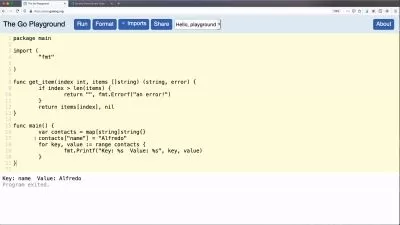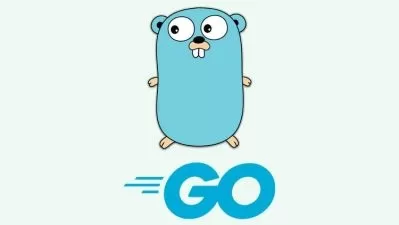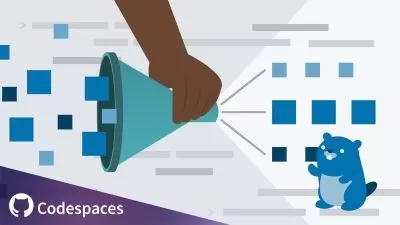Mastering Golang: From Fundamentals to Advanced Projects
EDUCBA Bridging the Gap
22:42:46
Description
Master Golang from scratch to advanced projects and elevate your programming skills with hands-on experience.
What You'll Learn?
- Master Golang Basics: Understand the core principles of Golang, including installation, syntax, and fundamental programming concepts.
- Develop Coding Skills: Learn various methods of writing Go code, declaring variables, writing functions, and implementing constants.
- Handle Data Structures: Gain expertise in arrays, maps, and slices, and understand how to work with different data types and structures effectively.
- Implement Control Structures: Explore control flow mechanisms like loops, switch cases, and error handling to create robust and efficient code.
- Use Advanced Features: Delve into closures, goroutines, channels, and concurrency to develop high-performance, multi-threaded applications.
- Manage Error Handling: Learn best practices for error handling in Go to build reliable and error-resistant software.
- Build and Use Interfaces: Understand how to implement and use interfaces to create flexible and scalable code.
- Develop Web Applications: Gain practical experience in building web applications with Golang, including creating templates, handling search functionality.
- Create REST APIs: Learn to integrate Golang with MongoDB to build and manage REST APIs, and use tools like Postman for database operations.
- Work on Real Projects: Apply your skills in hands-on projects that involve creating APIs and web applications, providing practical experience.
Who is this for?
What You Need to Know?
More details
DescriptionCourse Introduction
Unlock the power of Go (Golang) with our comprehensive course designed for both beginners and experienced developers. This course will guide you through the essentials of Go programming, advanced features, and real-world applications. From understanding basic syntax to creating complex applications, you’ll gain the skills needed to excel in Go development.
Section 1: Golang Fundamentals
In this section, you will be introduced to the basics of Golang, starting with its installation and initial setup. You'll explore various methods of writing Go code, including variable declaration, function creation, and the implementation of constants. Learn how to execute multiple files and handle different data types with functions that return multiple values. We will delve into control structures like loops and switch cases, explore advanced topics such as closures, error handling, and concurrent programming using goroutines and channels. The section will also cover essential Go data structures like arrays, maps, and slices, and how to implement interfaces and manage error handling effectively.
Section 2: Google Go Golang Programming Series (Module #1) - Golang Fundamentals
Building on the basics, this section covers deeper aspects of Go programming. You’ll learn about arithmetic operators, string manipulation, and conversions. Explore environment variables, formatting codes, and dependencies management. Understand Go packages, visibility, and numerical types to streamline your programming tasks. This module will also introduce you to initializing functions and interactions with other languages, enriching your Go programming experience.
Section 3: Google Go Golang Programming Series (Module #2) - Strings, Controls, and Functions
Dive into advanced string handling and control flow with Go. This section includes detailed lessons on string conversions, handling times and dates, and using pointers. Explore various control structures such as if-else statements, switch cases, and iterations. Learn about Go functions, including built-in and recursive functions, and how to use blank identifiers and defer for better code management.
Section 4: Google Go Golang Programming Series (Module #3) - Arrays, Maps, and Packages
Enhance your understanding of Go’s data handling capabilities. This section covers advanced topics like appending and copying slices, applying closures, and building packages. Learn about multidimensional arrays, map capacity, and how to pass slices to functions. Explore sorting, searching, and using the Go standard library effectively, including working with regular expressions and the sync package.
Section 5: Project on Golang and MongoDB - Creating Rest API
Apply your Go skills in a practical project involving Golang and MongoDB. This section focuses on creating a REST API, managing Docker containers, and working with MongoDB clients. You'll use Postman for database operations and handle person data using IDs. This project will solidify your understanding of integrating Go with databases and APIs.
Section 6: Project - Creating Web Application with Golang
Put your Go knowledge to the test by developing a web application. This section walks you through creating a web service, handling templates, and adding search functionality. Learn to structure your web application, resolve formatting issues, and implement pagination for search results. This hands-on project will provide a comprehensive experience in building and deploying web applications using Golang.
Conclusion
By the end of this course, you will have a thorough understanding of Golang, from fundamental concepts to advanced programming techniques. Whether you’re building APIs or web applications, you’ll be equipped with practical skills and knowledge to tackle real-world projects confidently.
Who this course is for:
- Aspiring Golang Developers: Individuals who want to learn Go from scratch or enhance their existing knowledge in Golang to build robust applications.
- Software Engineers: Professionals seeking to expand their skill set by adding Go to their programming repertoire, particularly those interested in systems programming, cloud computing, or backend development.
- Programmers Transitioning to Go: Developers familiar with other programming languages who wish to transition to Golang and leverage its unique features for efficient coding and concurrent programming.
- Tech Enthusiasts and Hobbyists: Those passionate about programming and technology who are eager to explore Golang’s capabilities for personal projects or to stay updated with industry trends.
- Students and Learners: Individuals in academic settings or coding bootcamps who need a comprehensive introduction to Golang as part of their curriculum.
- Project Managers and Technical Leads: Professionals involved in overseeing software development projects who want to understand Golang’s strengths and applications to make informed decisions.
Course Introduction
Unlock the power of Go (Golang) with our comprehensive course designed for both beginners and experienced developers. This course will guide you through the essentials of Go programming, advanced features, and real-world applications. From understanding basic syntax to creating complex applications, you’ll gain the skills needed to excel in Go development.
Section 1: Golang Fundamentals
In this section, you will be introduced to the basics of Golang, starting with its installation and initial setup. You'll explore various methods of writing Go code, including variable declaration, function creation, and the implementation of constants. Learn how to execute multiple files and handle different data types with functions that return multiple values. We will delve into control structures like loops and switch cases, explore advanced topics such as closures, error handling, and concurrent programming using goroutines and channels. The section will also cover essential Go data structures like arrays, maps, and slices, and how to implement interfaces and manage error handling effectively.
Section 2: Google Go Golang Programming Series (Module #1) - Golang Fundamentals
Building on the basics, this section covers deeper aspects of Go programming. You’ll learn about arithmetic operators, string manipulation, and conversions. Explore environment variables, formatting codes, and dependencies management. Understand Go packages, visibility, and numerical types to streamline your programming tasks. This module will also introduce you to initializing functions and interactions with other languages, enriching your Go programming experience.
Section 3: Google Go Golang Programming Series (Module #2) - Strings, Controls, and Functions
Dive into advanced string handling and control flow with Go. This section includes detailed lessons on string conversions, handling times and dates, and using pointers. Explore various control structures such as if-else statements, switch cases, and iterations. Learn about Go functions, including built-in and recursive functions, and how to use blank identifiers and defer for better code management.
Section 4: Google Go Golang Programming Series (Module #3) - Arrays, Maps, and Packages
Enhance your understanding of Go’s data handling capabilities. This section covers advanced topics like appending and copying slices, applying closures, and building packages. Learn about multidimensional arrays, map capacity, and how to pass slices to functions. Explore sorting, searching, and using the Go standard library effectively, including working with regular expressions and the sync package.
Section 5: Project on Golang and MongoDB - Creating Rest API
Apply your Go skills in a practical project involving Golang and MongoDB. This section focuses on creating a REST API, managing Docker containers, and working with MongoDB clients. You'll use Postman for database operations and handle person data using IDs. This project will solidify your understanding of integrating Go with databases and APIs.
Section 6: Project - Creating Web Application with Golang
Put your Go knowledge to the test by developing a web application. This section walks you through creating a web service, handling templates, and adding search functionality. Learn to structure your web application, resolve formatting issues, and implement pagination for search results. This hands-on project will provide a comprehensive experience in building and deploying web applications using Golang.
Conclusion
By the end of this course, you will have a thorough understanding of Golang, from fundamental concepts to advanced programming techniques. Whether you’re building APIs or web applications, you’ll be equipped with practical skills and knowledge to tackle real-world projects confidently.
Who this course is for:
- Aspiring Golang Developers: Individuals who want to learn Go from scratch or enhance their existing knowledge in Golang to build robust applications.
- Software Engineers: Professionals seeking to expand their skill set by adding Go to their programming repertoire, particularly those interested in systems programming, cloud computing, or backend development.
- Programmers Transitioning to Go: Developers familiar with other programming languages who wish to transition to Golang and leverage its unique features for efficient coding and concurrent programming.
- Tech Enthusiasts and Hobbyists: Those passionate about programming and technology who are eager to explore Golang’s capabilities for personal projects or to stay updated with industry trends.
- Students and Learners: Individuals in academic settings or coding bootcamps who need a comprehensive introduction to Golang as part of their curriculum.
- Project Managers and Technical Leads: Professionals involved in overseeing software development projects who want to understand Golang’s strengths and applications to make informed decisions.
User Reviews
Rating
EDUCBA Bridging the Gap
Instructor's Courses
Udemy
View courses Udemy- language english
- Training sessions 156
- duration 22:42:46
- Release Date 2024/10/30










